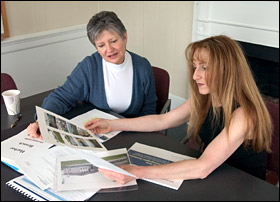| Financials |
 |
Report
from the Vice President for Finance & Administration &
Chief Financial Officer |
 |
Financial
Statements |

|
 |
Financials > Report from the
Vice President for Finance & Administration & Chief
Financial Officer
Report
from the Vice President for Finance & Administration &
Chief Financial Officer
 |
 |
|
Carolyn Bunker (left) with Controller Stacey Medeiros. (Photo by Tom Kleindinst) |
The Institution maintained its strong financial
position during 2003. Although ocean sciences funding at the federal level was flat, our government-sponsored research revenue increased
slightly. This is a tribute to the skill of our researchers, who continue to compete successfully for support despite a difficult funding environment.
Financial Position
Total net assets increased $50.9 million, from $290.8 million in 2002 to $341.6 million in 2003. Net assets are presented in three categories to demonstrate
one significant difference between for-profit companies and not-for-profit institutions. The categories
represent the restrictions placed on revenue recognized.
Permanently restricted net
assets are gifts whose principal can never
be spent. They include gifts and pledges to true endowment and
assets held in trust, such as life income funds, that will be
added to the endowment when they mature or are received.
Temporarily restricted net
assets are gifts that, after an event or
passage of time, can be used to meet operating or capital initiatives.
This category also includes accumulated market gains on permanently
restricted endowment funds. The Commonwealth of Massachusetts
requires that not-for-profit institutions include accumulated
market gains on both permanently and temporarily restricted
net assets with temporarily restricted net assets. Most other
states allow these gains to be included in unrestricted net
assets. If the Institution were to follow the prevalent rule,
unrestricted net assets would increase by $30.1 million and
temporarily restricted net assets would decrease by a like amount.
Unrestricted net assets
include the remaining financial resources available to the Institution.
At year end the Institution had $10.7 million in long-term debt compared with $8 million in 2002. We anticipate that tax-exempt bonds issued by WHOI through the Massachusetts Health and Educational Facilities Authority will finance a substantial
portion of the new laboratory space on the Quissett Campus and renovations to existing laboratory
space on the Village Campus.
Activities
Sponsored research revenue released to operations
increased to $100.7 million in 2003 compared to $97.5 million in 2002, and government-sponsored research, excluding ship and submersible operations, was $63.4 million compared to $59.1 million in 2002. Total revenues increased 9.4 percent from $123.2 million in 2002 to $134.8 million in 2003.
Gifts, grants, and pledges from private sources totaled
$23.9 million in 2003, an increase of 73.2 percent over 2002. Outstanding pledges at the end of 2003 were $4.8 million, compared to $4.5 million in 2002.
The market value of investments in the endowment increased from
$234.6 million in 2002 to $269.3 million in 2003. The investment
policy focuses on total return, a combination of capital appreciation
and income from interest and dividends. In 2003 the total return
on investments was 21.8 percent compared with an 11 percent
decline in 2002. Our endowment spending policy preserves the
fundís real purchasing power while providing a predictable stream
of income to support annual budgetary needs. During 2003 we
distributed $13.6 million of endowment assets: $5.7 million
to education, $4.7 million to research, and $3.2 million to
other restricted and unrestricted funds.
Although the financial results of 2003 were positive, we recognize
an increasing stress on our scientists and engineers to secure
funding for research. Federal funding, while steady, is not
growing, and pension and health care costs are increasing faster
than our ability to fund them. The major construction projects
planned for the next few years, while providing essential additional
laboratory space, will add to the cost of research. However,
the Institution is launching a major fund-raising effort to
provide broad support for science and education. With additional
financial support from private sources and the ability and resourcefulness
of our scientists, engineers, students, and staff, we believe
the challenges, while difficult, will be met.
—Carolyn Bunker (cbunker@whoi.edu)
Vice President for Finance & Administration & Chief
Financial Officer
|
|
